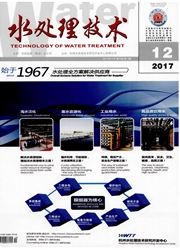

 中文摘要:
中文摘要:
本文利用直接制备的碳纳米管原始样品作为偶氮染料的吸附剂,采用次氯酸钠溶液对碳纳米管进行表面修饰改性,改性后显著提高了吸附剂的吸附容量,本工艺简单有效,所获得的吸附剂具有磁性,吸附过后用磁铁易于达到固液分离的效果。吸附性能结果表明,次氯酸钠改性后碳纳米管对水中甲基橙去除效果明显高于未改性的碳纳米管。吸附剂对水中甲基橙的吸附在70min基本达到平衡,吸附过程符合准2级动力学模型(R2〉0.99)。改性后的磁性碳纳米管吸附甲基橙的平衡吸附量qe与甲基橙溶液的平衡浓度Pe的关系满足Langmuir(R2〉0.99),Freundlich(R2〉0.98)以及Dubinin-Radushkevich(D—R)(R2〉0.99)等温吸附模型。通过Langmuir模型计算可知改性磁性碳纳米管最大吸附容量为29.2mg·g^-1,吸附过程为有利吸附,由D—R模型计算结果可以推断,次氯酸钠改性后的磁性碳纳米管对水溶液中甲基橙的吸附以物理吸附为主。
 英文摘要:
英文摘要:
In this paper, the adsorption of azo-dyes in water was investigated using as-synthesized magnetic carbon nanotubes (mCNTs) modified by NaCIO. In particular, the adsorption capacity of modified mCNTs for methyl orange was significantly higher than that of the pristine mCNTs. This method to remove methyl orange was simple and effective. The new adsorbent could be easily separated from aqueous solution after adsorption due to its magnetic properties. The adsorption of methyl orange reached equilibrium within 70 minutes of adsorption. Kinetic analyses were conducted using pseudo first- and second-order models and the intraparticle diffusion model. The regression results showed that the adsorption kinetics were more accurately represented by pseudo second-order model (R2〉0.99). The equilibrium adsorption data were analyzed using three widely applied isotherms: Langmuii', Freundlich and Dubinin-Radushkevich (D-R). The results suggested that all isotherm models can fit the experimental data reasonably well. Based on the Langmuir model, the maximum adsorption capacity of modified mCNTs was 29.2 mg .g 6-1, and the adsorption process was favored. The adsorption mechanism ofmCNTs modified by NaCIO on methyl orange was mainly attributed to the ohvsical adsomtion based on the D-R model.
 同期刊论文项目
同期刊论文项目
 同项目期刊论文
同项目期刊论文
 One-pot, large-scale synthesis of magnetic activated carbon nanotubes and their applications for ars
One-pot, large-scale synthesis of magnetic activated carbon nanotubes and their applications for ars A facile one-pot method for synthesis of low-cost iron oxide/activated carbon nanotube electrode mat
A facile one-pot method for synthesis of low-cost iron oxide/activated carbon nanotube electrode mat Self-regenerative adsorbent based on the cross-linking chitosan for adsorbing and mineralizing azo d
Self-regenerative adsorbent based on the cross-linking chitosan for adsorbing and mineralizing azo d Magnetic carbon nanotubes synthesis by Fenton's reagent method and their potential application for r
Magnetic carbon nanotubes synthesis by Fenton's reagent method and their potential application for r Diameter-dependent thermal-oxidative stability of single-walled carbon nanotubes synthesized by a fl
Diameter-dependent thermal-oxidative stability of single-walled carbon nanotubes synthesized by a fl A facile one-pot method for synthesis of low-cost magnetic carbon nanotubes and their applications f
A facile one-pot method for synthesis of low-cost magnetic carbon nanotubes and their applications f 期刊信息
期刊信息
